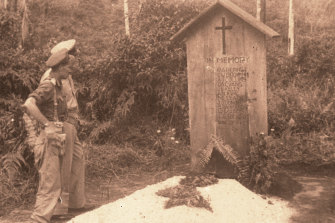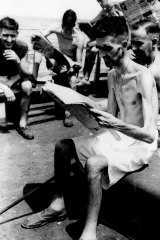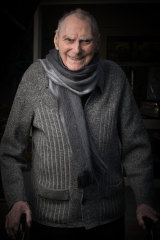Max Gilbert awoke to discover a man on either side of him had died in the night.
“I remember their names even to this day: Les Brown was on my right, and Les Fairbrother — the two Leses — Les Fairbrother on the other side of me,” Gilbert recalls.
Australian prisoner of war graves on the Indonesian island of Ambon.Credit:Archive
It was April 24, 1944. It was Private Maric (Max) Gilbert's 23rd birthday.
He hovered near death himself as he endured the reeking dysentery hut of the Tan Tui prisoner of war camp on the island of Ambon, now part of Indonesia. The hut was called “the mortuary”.
Gilbert, however, possessed a deep well of resilience. He became the first and, he is pretty sure, the only prisoner to leave the mortuary alive.
A year-and-a-half later, when World War II was finally done, he would become one of the few who made it home to Australia.
Gilbert was among 1131 Australians who were sent, in a breathtaking act of military dereliction, to assist a Dutch contingent to protect Ambon from Japanese invasion in late 1941.
Commanders in Australia, it would emerge, knew before the battalion sailed that it was a doomed mission. The Australian 2/21st Battalion, known as Gull Force, was defeated in just four days, from January 30 to February 3, 1942, when a Japanese force of 20,000 invaded Ambon.
What followed was among the worst atrocities of World War II. More than 300 young men — 229 of them Australians — were beheaded over a period of two weeks.
The remainder of those who had survived the brief Battle of Ambon were condemned to one of the most brutal periods of captivity in military history. By the end of the war, 779 of those 1131 Australians — more than two in every three — were dead.
Survivors of Gull Force returning to Australia on a hospital ship in 1945 catch up on the news.Credit:Archive
Apart from the Sandakan Death Marches on Borneo in 1945, during which 2434 Allied POWs died, Ambon and an associated POW camp on the southern Chinese island of Hainan amounted to the most abominable chapter of the war.
And yet, despite several books and articles detailing the monstrous futility of it all, 75 years after the war few Australians know much, if anything, about Ambon.
Perhaps, the story was too overwhelming to be digested by a nation recovering from the war. Perhaps, there were too few left alive to tell it. And perhaps, Australia’s military and political authorities were so ashamed they wanted to throw a blanket over Ambon and forget it.
There was, it transpired, much that needed forgetting.
Apart from the disgrace of sending a battalion into a guaranteed catastrophe, it emerged that in both the Ambon and Hainan camps, senior Australian officers had turned against their own men.
Now aged 99, Gilbert is the last survivor of the torment that was imprisonment by the Japanese on Ambon from early 1942 until September 1945. (One other Australian who was captured on Ambon but was transferred to Hainan also survives but according to the Gull Force Association, he does not speak of those years.)
Gilbert lives now in an aged care facility in Boronia, an eastern suburb of Melbourne.
Each morning, he climbs from his bed and does a series of physical exercises. Apart from fading eyesight, he is free of illness, just as he has been for most of his post-war years.
With the 75th anniversary of World War II at hand — the Japanese surrendered on August 14, 1945, though they didn’t tell the POWs on Ambon until September — I rang Gilbert, seeking wisdom about how the human heart might deal with being denied all that is considered normal.
Max Gilbert, at 99 the only living survivor of the Japanese POW camp in Ambon. Credit:Jason South
He recognised immediately an unspoken part of the question. Yes, he said, all of Melbourne was locked away from normal life now. The pandemic.
“You just have to go on, day to day,” he said. “That’s all I can say.”
He insisted he had long ago come to terms with his broken years, though he still wanted the story to be told, for there was a lonely cemetery on the island of Ambon accommodating more than 2000, half of them Australians.
It had taken him 20 years to jettison the hatred of Japanese that had grown within him during the years of routine beatings, torture, starvation and illness. He no longer hated nor dwelt on the horror. “I’ve put it all away,” he said.
He no longer lingered over something else that ate at him and other survivors for decades, either: an abiding contempt for some of the officers of the 2/21st.
The truth is that the commanding officer on Ambon, Major George de Verdon Westley, established his own form of punishment for Australians who, starving, dared to raid the officers’ vegetable garden.
Westley ordered a “cage” of barbed wire be built and had pilferers from the ranks, many suffering malaria and worse, thrown into it, there to be exposed through long nights to the tropical elements. The cage was two metres square. A man could barely move without jagging his skin on the barbs.
Another Australian commanding officer, Lieutenant-Colonel William John Rendell Scott, veteran of Gallipoli and the Western Front, was never forgiven by his men for unthinkable behaviour after he left Ambon to oversee the prisoners transferred to Hainan.
Trying to maintain discipline, Scott took to handing over his own men to be punished by the Japanese.
Historian Joan Beaumont (Gull Force: Survival and Leadership in Captivity 1941-1945) and author Roger Maynard (Ambon: the Truth About One of the Most Brutal POW Camps in World War II and the Triumph of the Aussie Spirit) have documented the most shocking incident.
A young private, George Roy, of Deniliquin, while sick in hospital at the Hainan camp, took a shower during the period reserved for officers. Challenged, he verbally abused an officer.
Scott sentenced Roy to be punished by the Japanese. He waited three months while Roy lay in hospital, and when the boy had recovered enough to stand, insisted the sentence be carried out.
Roy was given a choice: stand bound by his thumbs to a crossbar while a Japanese guard flogged him with a pick handle, or have a wire tied from his thumbs to his toes via his testicles and an electrical charge applied.
Roy chose the beating, which was so severe the Australian medical officer at the camp, Dr Bill Aitken, was sure he would die. Roy managed to survive, his body pulped. Scott never recovered his authority or reputation.
Gilbert’s smouldering fury lasted for decades. In 2003, he made clear he wanted the wider public to know about it when he gave a long interview to the University of NSW Australians at War Film Archive. When I phoned this week, he directed me to the old interview rather than expend emotional energy on the subject.
He was convinced, his interview made clear, that one of his closest mates in the Ambon camp, a fellow named Jack Morrow, had suffered so much during a stretch in the "cage" that it had hastened his death only weeks before the end of the war.
Gilbert — nicknamed "Eddie" after the cricketer Eddie Gilbert, who once bowled Don Bradman — experienced particular grief at losing Eric Stagg, the best mate who helped save his life.
“I can remember when I was in hospital with dysentery, the day was long, and one of the things I looked forward to was Eric coming home from a work party and sticking his head through the opening, which was a window, and saying: ‘How are you going, Eddie?'
“And if for some reason or another he was late, I fretted like mad. That was so important to me just for him to come and stick his head through the window and say: ‘How are you going, Eddie?’ That moral support that a mate could give, and did give …”
And there it was: the quality old soldiers might tell you was the only reliable good to be found in the cursed loneliness of war. Mateship.
Source: Read Full Article





